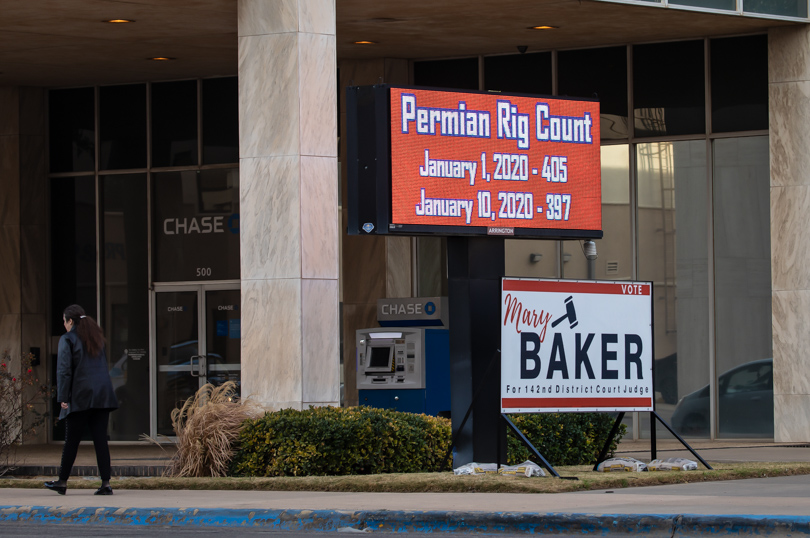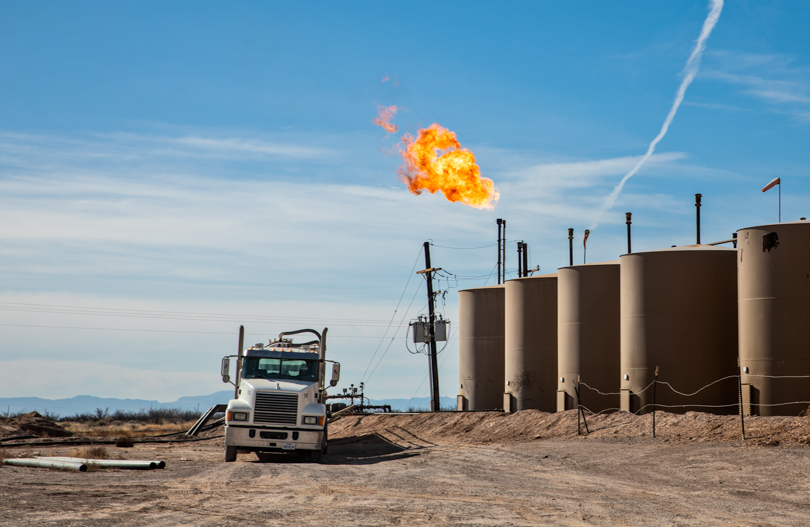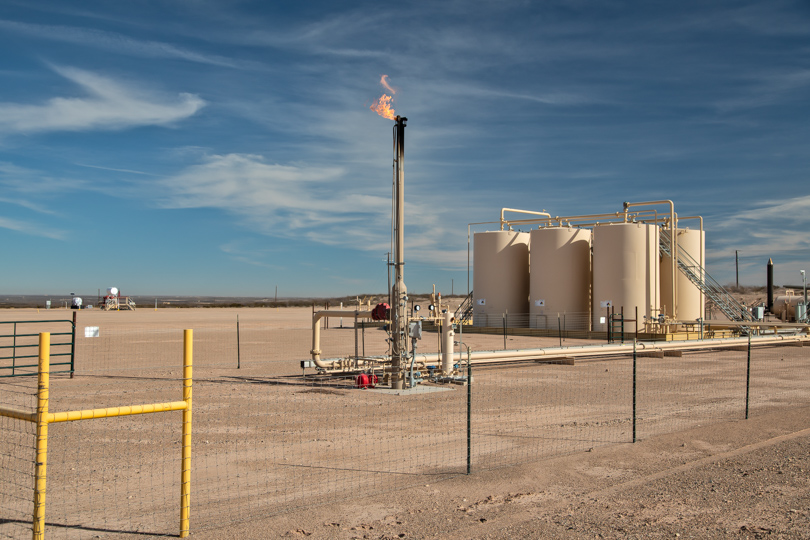Meaningful regulation of the fracking industry is a non sequitur to Sharon Wilson, organizer for Earthworks’ Oil & Gas Accountability Project. She supports her employer’s efforts to encourage tougher industry regulations, but believes that humankind needs to keep oil and gas in the ground if there is any chance of meeting the benchmarks set by the Paris Climate Accord to limit global warming.
After spending a couple days with Wilson as she monitored for methane leaks at oil and gas industry sites in the Permian oilfields of West Texas, it is easy to understand why she believes that talk of meaningful regulation of the industry lacks meaning itself.
Flares at Eagle Claw Midstream Pecos Bend Gas Plant next to what is known as a “man camp” where the primarily male workers live in temporary housing.
Sharon Wilson, a certified optical gas imaging operator, at work for Earthworks in the Permian Basin.
Wilson uses an optical gas imaging (OGI) camera, which makes otherwise invisible emissions visible. With the specialized camera, also used by environmental regulators and industry, she recorded fugitive emissions spewing from nearly every site we visited.
Welcome to the Permian Basin
The handful of places we stopped were only a tiny fraction of the countless oil and gas production sites in the Permian Basin. This region, one of the most prolific oil and natural gas plays in the U.S., spans approximately 86,000 square miles in West Texas and southeastern New Mexico. The basin is roughly 250 miles wide and 300 miles long and is in the midst of an oil boom.
In 2014 the basin’s fracking industry began ramping up, using horizontal drilling and high-pressure fluid injections to crack open shale and release the oil and gas trapped inside. Though the boom has recently cooled off in the region, there is still plenty of new drilling activity.
LED sign in Midland, Texas, that flashed between the prices of gas and oil and the number of rigs operating in the Permian Basin. There were 397 rigs operating on January 10, 2020, down from 489 in November 2018.
Midland, Texas’s skyline behind an oil and gas production site.
A drill site visible from the window of the Comfort Inn in Midland, Texas.
Because oil is much more profitable than natural gas, producers here tend to “flare” the gas, which is mostly methane, setting it on fire to turn the powerful short-term greenhouse gas into carbon dioxide.
Methane is up to 86 times more potent than carbon dioxide in the first 20 years after entering the atmosphere. According to a 2018 report organized by the Environmental Defense Fund, the U.S. oil and gas supply chain is leaking roughly 60 percent more methane than reported in previous Environmental Protection Agency (EPA) estimates, which largely relied on industry self-reports.
A November 2019 study found that methane emissions from the oil and gas industry in the south-central United States, which includes the Permian Basin, are twice EPA estimates. E&E News reported, “Oil and gas emissions are currently being underestimated, and they are likely the largest source of human-made methane emissions in the U.S.,” according to Zachary Barkley, a Penn State researcher in meteorology and atmospheric science and co-author of the study, published in the journal Geophysical Research Letters.
Flare at an oil and gas production site in the Permian Basin near Pecos,
A report by DeSmog’s Justin Mikulka states that the flaring of natural gas at industry sites in the Permian is second only to those in the Bakken Shale in North Dakota. Permian flaring reportedly doubled in 2018, with an estimated $1 million a day of gas burned off instead of being transported and sold.
Drilling Rules
The Trump administration has moved to reverse 2017 rules for drillers on tribal and federally controlled lands which was put in place under Obama, regulations that many environmental advocates didn’t think went far enough. The New York Times reported that if the rollbacks Trump advocates are not reversed, “by the EPA’s own calculations, the rollback would increase methane emissions by 370,000 tons through 2025, enough to power more than a million homes for a year.”
The attorneys general from California and New Mexico sued the Trump administration to stop the rollbacks. The suit has yet to be decided.
During a public comment hearing about the rule rollback in Texas on October 17, 2019, Tim Doty, a former senior official at the Texas Commission on Environmental Quality (TCEQ), objected to the measure. “I sincerely hope that the EPA has the courage to maintain and improve current environmental standards associated with greenhouse gas emissions, including but not limited to methane, as the future of our planet demands it,” Doty said during his testimony.
Doty testified about the shortcomings of the regulatory agency he spent 31 years working for, ranging from a failure to do minimal environmental enforcement to unethical behavior, including retaliation against employee whistleblowers. He said that the agency “took away employees’ respirators because it was and still is scared of the public perception about using one.”
“Please realize that emissions are typically very understated and are only estimated since actual emission measurements are not mandated,” he said. Doty concluded that it is outrageous that the federal government is proposing rolling back existing volatile organic compound (VOC) and greenhouse gas regulations while apparent methane emissions remain prevalent in all oil and natural gas sectors.
US Highway 285, known to locals as Death Highway due to the many fatal accidents on the road.
Rolling back federal emission rules before they had a chance to be implemented flies in the face of scientists’ warnings that catastrophic climate change could be unstoppable if greenhouse gas emissions are not greatly reduced very soon.
“There has never been a system in place to adequately regulate this industry,” Wilson said. She believes it is too late to set up such a system now. “It would cost far too much money which we need to put in renewable energy resources.” The oil and gas industry is continuing to drill more wells, build more petrochemical plants, and dig new pipelines, activities in conflict with meeting the Paris Accord goals of limiting warming to less than 2˚C (3.6˚F).
Oilfield Hazards
Wilson, who is based in Dallas, makes frequent trips to the Permian Basin, where conditions are tough. She shrugs off the hardships she faces out in the field, pointing out that for the people who live in the area, it is much worse.
During our first stop, she picked up a twig with long, sharp thorns and warned me to watch my step. She also has to watch out for distracted drivers, as many of the roads are narrow and have no divider between her vehicle and fast-moving, oncoming traffic.
The air pollution in the oilfields often gives Wilson a scratchy throat and intermittent headaches. In addition, there is the threat of exposure to hydrogen sulfide (H2S). Depending on the concentration, this potentially deadly gas can kill someone within minutes, and can be found escaping from oil and gas production sites. And the lack of healthy food in most of the area’s restaurants has her relying primarily on energy bars during her road trips.
But for Wilson, the long hours she puts in documenting leaking methane and showing that work to journalists like me and a team from the New York Times, is well worth the effort. The Permian’s methane emissions are a huge driver in the climate crisis, one that needs to be more widely addressed to meet international climate goals.
Billboard in Pecos, Texas, where finding a meal for a vegetarian isn’t easy.
Warning sign for hydrogen sulfide, which can be deadly, at an oil and gas production site.
“It’s increasingly clear that fossil fuel production has dramatically increased global methane emissions,” said Robert Howarth, an earth system scientist at Cornell University and author of a study estimating that North American shale gas production may be responsible for about a third of the global increase in methane emissions over the past decade.
Because natural gas has been promoted by industry, politicians, and even some environmentalists as a “bridge fuel,” many don’t realize that methane leaking during oil and gas production negates the advantage of using natural gas instead of coal for energy, scientists say. While natural gas burns cleaner than coal, the methane that escapes during the production process has a potent warming effect on the climate.
According to a recent Bloomberg report, “Producers in the Permian are already flaring record levels of natural gas. The Texas Railroad Commission, which oversees the oil and gas industry in the state, has granted nearly 6,000 permits allowing explorers to flare or vent natural gas this year. That’s more than 40 times as many permits granted at the start of the supply boom a decade ago.”
Repeat Offenders
On the outskirts of Pecos, Wilson found multiple sites leaking methane on state land. The sites belonged to oil and gas company Diamond Back. At some of them she detected leaking methane for three days in a row. And at one, called “Desperado,” she thought what she was seeing was not only a potential violation, but an emergency situation because the emissions were so dense. She reported it to the TCEQ, calling from the site.
After reporting her findings, Wilson was put on hold. The agency’s recorded message intermittently played music and information about the agency’s work. TCEQ’s recording gave advice on fixing water leaks and reminded those waiting on hold to “Remember, take care of Texas — it is the only one we have got.”
Wilson makes a point to revisit sites where she previously found methane emissions, tracking the pollution and how the TCEQ is responding, if at all. She had previously filed a complaint about the Desperado site. When she called from the field, sitting across from an unlit flare bellowing methane, she had hoped to speak with someone with direct knowledge of the complaints she had previously filed about that very site and others nearby. Unsuccessful, she shrugged and went on with inspecting the sites she had set out to monitor.
I asked the TCEQ if the numerous reports Wilson has filed over the last couple years concerned the agency but didn’t receive a reply before publication.
Cattle on state land outside of Pecos, Texas.
Home in Midland, Texas, next to an oil and gas production site.
Wilson sees a bright side to her work. “If we stop emitting methane, it will immensely slow the warming of the planet,” she said, offering a known solution. However, she added, we are doing the opposite. Instead of prioritizing moving towards renewable energy, the U.S. is drilling and fracking more oil and gas for export, releasing vast amounts of methane in the process.
Oil and gas industry services sign using President Trump’s campaign slogan.
Wilson knows her stance that fracking should be banned isn’t popular with some environmental advocates, who are working toward establishing industry rules to halt leaking methane. While she understands their intentions, and agrees new rules would be good, she says they cannot be used as an excuse to let the oil and gas industry continue expanding. She maintains that “the time to save the planet is limited.” That is what climate scientists have said, and she accepts the science.
Flare at an oil and gas production site on state land near Pecos, Texas.
Main image: Sharon Wilson with an optical gas imaging camera next to the Lara Cemetery near a Diamond Back oil and gas production site outside of Pecos, Texas. Credit: All photos and video by Julie Dermansky for DeSmog
Subscribe to our newsletter
Stay up to date with DeSmog news and alerts




















